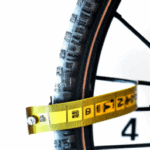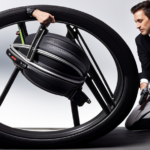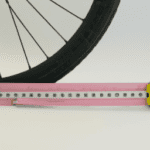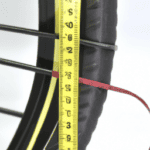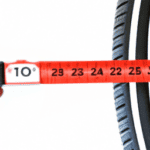Being a cyclist necessitates understanding the dimensions of your bicycle’s wheel. When you’re in the market for new tires or even a whole new bicycle, possessing precise dimensions ensures you select appropriately.
Measuring the size of your bike wheel may seem daunting, but with the right tools and knowledge, it can be a straightforward process. To accurately measure your bicycle wheel size, you will need a measuring tape, a ruler, or a caliper. These tools will help you measure the diameter and width of your wheel.
Once you have the measurements, you can determine the type of wheel you have and use this information to shop for new tires or bikes. With this article, I will guide you through the steps of measuring your bike wheel size so that you can confidently make informed decisions when it comes to your cycling needs.
Key Takeaways
- Measuring the size of your bicycle wheel is important when shopping for new tires or bikes.
- Accurate measurements of the wheel diameter, rim circumference, and width are necessary to avoid issues with brakes and tire clearance.
- Different types of bicycles require specific wheel sizes, such as narrow 700c wheels for road bikes and wider 26-29 inch wheels for mountain bikes.
- Investing in quality products may save money in the long run by reducing the need for frequent repairs or replacements.
Gather the necessary tools
Before you hit the road, make sure you’ve got the right gear. This includes a tape measure, a set of calipers, and a truing stand to accurately determine the size of your bicycle wheel. Choosing the right gauge is important as you need to measure the wheel size accurately to avoid issues with the brakes and tire clearance.
A tape measure is a good tool to have on hand, but it might not be precise enough, especially if you’re measuring a small wheel. In this case, a set of calipers will give you a more accurate reading. A truing stand is also handy if you need to make sure the wheel is perfectly round.
Getting an accurate reading is crucial when measuring the size of your bicycle wheel. To measure the diameter of the wheel, place the bike on a level surface, and spin the wheel to find the highest point. From there, measure the distance from the ground to the highest point on the tire. This measurement will give you the diameter of the wheel, which you can then use to determine the size of the wheel.
With these tools and techniques, you can accurately determine the size of your bicycle wheel and ensure that your bike is in good working order.
Measure the diameter of the wheel
To measure the diameter of my bicycle wheel, I need to first determine the valve position.
Then, I’ll measure from one point on the rim to the opposite point, making sure to go through the center of the wheel.
Finally, I’ll convert the measurement from millimeters to inches if necessary.
This process requires precision and attention to detail to ensure accurate results.
Determine the valve position
First, take a look at your bicycle tire and locate the valve stem. Valve stem location is important because it affects the measurement of the wheel size. Once you’ve located the valve stem, take note if it’s on the outside edge of the tire or closer to the center. This will help determine the correct wheel size measurement.
It’s also important to check if the rim tape is compatible with the valve type to ensure proper fit and inflation.
When measuring your bicycle wheel size, it’s essential to measure from one point on the rim to the opposite point. This will give an accurate measurement of the diameter of the wheel. By measuring the diameter of the wheel, you can determine the correct size of tire to use.
When measuring the wheel size, ensure that you measure the widest part of the rim and not the tire.
Measure from one point on the rim to the opposite point
Now you can easily determine the diameter of your bike’s wheel by measuring from one point on the rim to the opposite point. This measurement is the rim circumference and must be converted to the diameter by dividing it by pi (3.14).
Make sure to measure the rim, not the tire, as different tires can be compatible with the same size rim. To measure the rim circumference, place the tape measure against one point on the rim and stretch it across to the opposite point. Use your thumb to keep the tape in place and read the measurement.
Remember to measure the rim, not the tire, as different tires can fit on the same size rim. This measurement will be used to determine the diameter of the wheel, which is important for tire compatibility.
To convert millimeters to inches (if necessary), divide the measurement by 25.4. This will give you the diameter of the wheel in inches. By measuring the rim circumference and converting it to diameter, you can ensure you purchase the correct sized tire for your bike.
Convert millimeters to inches (if necessary)
You might be surprised to learn that converting millimeters to inches is easier than you think. It’s a common task when measuring bicycle wheel size, as many manufacturers provide measurements in millimeters. However, if you’re used to thinking in inches, it’s important to understand the differences between the metric and imperial systems.
Metric measurements use units based on the International System of Units (SI), which is widely used around the world. Imperial measurements, on the other hand, are based on the units used in the United States and other countries that have historical ties to the British Empire. While the metric system is more common in scientific and technical fields, imperial measurements are still used in many everyday situations.
When converting millimeters to inches for bicycle wheel size, it’s important to be aware of both systems and their pros and cons. Additionally, you may need to convert other bicycle measurements, such as tire width or frame size, which can also be measured in either metric or imperial units.
To measure the width of the wheel, simply place a ruler or tape measure across the rim from one side to the other. But before you do that, let’s dive a little deeper into the differences between metric and imperial measurements.
Measure the width of the wheel
To measure the width of a bicycle wheel, simply use a ruler or measuring tape and record the distance between the inner edges of the rim. It’s important to note that the width of the wheel is not the same as the wheel circumference, which is the distance around the entire outer edge of the tire.
Knowing the wheel circumference is important for determining tire compatibility, while knowing the wheel width is important for selecting the appropriate inner tube size. When measuring the wheel width, it’s best to take multiple measurements at different points around the rim to ensure accuracy.
Additionally, it’s important to take into account the depth of the rim when measuring the width. The depth of the rim can affect the fit of certain tire sizes, so it’s important to consider both the width and depth when selecting a tire.
Once you have measured the width of the wheel, you can move on to determining the wheel type based on its size and other identifying features.
Determine the wheel type
Figuring out the type of wheel you have is crucial for finding the right replacement parts and ensuring a smooth ride. There are different types of bicycle wheels, each designed for specific purposes.
Road bikes typically have narrow, lightweight wheels with a diameter of 700c while mountain bikes require wider and heavier wheels with a diameter of 26 inches, 27.5 inches, or 29 inches. Meanwhile, hybrid bikes usually have wheels that fall between the sizes of road and mountain bikes.
When measuring your wheel size, it’s important to consider the type of bike you have and the common wheel sizes for different types of bikes. This will help you determine the appropriate replacement parts or new bike that you need.
Understanding the type of wheel you have will also give you a better idea of what to look for when shopping for accessories, such as tires or rims. With this knowledge, you can ensure that you’re making the right purchase for your specific bike and riding needs.
Use the measurements to shop for new tires or bikes
Once you’ve got the right measurements, finding the perfect new tires or bike should be a breeze! To make the process even easier, consider the following steps:
-
Comparing tire brands: Before purchasing new tires, it’s important to research and compare different brands. Some brands may offer better durability, while others may have a specific tread pattern that suits your needs. Look for reputable brands that have a track record of producing high-quality tires.
-
Choosing the right bike model for your needs: If you’re in need of a new bike, it’s important to choose the right model for your needs. Consider the type of riding you’ll be doing and your skill level. Are you looking for a road bike for long distance rides or a mountain bike for off-road adventures? Make sure to test ride different models to find the one that feels most comfortable and suits your needs.
-
Checking compatibility: When shopping for new tires or a bike, make sure to check compatibility with your current setup. For example, make sure the tire size matches the measurements you’ve taken, and that the bike frame is compatible with the type of tires you’re looking to purchase.
-
Considering budget: Finally, consider your budget when making a decision. While it’s important to invest in quality tires or a bike that will last, be mindful of your financial constraints and choose a product that fits within your budget. Keep in mind that purchasing a higher-end product may save you money in the long run by reducing the need for frequent repairs or replacements.
Frequently Asked Questions
Can I use the same method to measure the wheel size of all types of bikes?
Yes, the method for measuring bicycle wheel size can be used for all types of bikes, but variations and inconsistencies in wheel sizes may exist. It is important to measure the specific bike’s wheel size accurately for optimal performance.
What is the standard range of wheel sizes for road bikes?
When choosing a wheel size for a road bike, it’s important to consider the benefits of different sizes. Smaller wheels offer greater maneuverability and acceleration, while larger wheels provide better stability and speed. Your riding style and preferences should guide your decision.
Is it possible to measure the wheel size accurately without removing the tire?
Measuring bicycle wheel size accurately without removing the tire is possible but can be challenging. Tire wear impacts measurement accuracy, and a precise technique is required to ensure a reliable measurement.
How can I tell if my bike has a tubeless wheel system?
To determine if my bike has a tubeless wheel system, I check the rim and tire for tubeless-specific markings and valves. The advantages of tubeless tires include reduced flats and improved traction. To convert a bike to tubeless, I must first choose compatible components and follow proper installation procedures.
Can I mix and match different wheel sizes on my bike?
Mixing different wheel sizes on a bike can affect handling and stability. It’s best to choose the appropriate size based on the bike’s frame and intended use. Proper measurement can ensure compatibility, preventing potential safety hazards.
Conclusion
So there you have it, measuring your bicycle wheel size can be quite easy and straightforward. With just a few tools and simple steps, you can accurately determine the size of your wheel and make informed decisions when it comes to shopping for new tires or bikes.
However, it’s important to note that while measuring your wheel size is a simple task, it’s also a crucial one. Choosing the wrong size tire or bike can lead to discomfort, decreased performance, and even safety hazards. So, take the time to measure your wheel size accurately and double-check your measurements before making any purchases.
By doing so, you’ll ensure that your biking experience is as comfortable and safe as possible.



